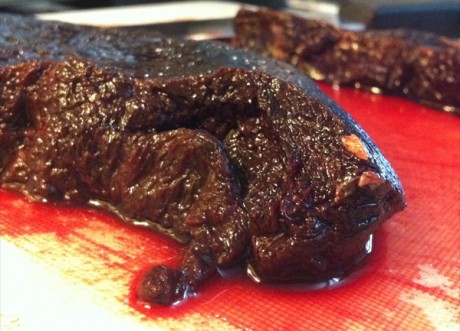Image may be NSFW.
Clik here to view.
Although many of you might be a little disheartened in the upcoming tasting choice, I for one feel that introducing myself to as many different foods, flavors, and textures allows me to appreciate the art of cooking, the passions for food and the appreciation of where our sustenance comes from.
An opportunity recently came up for me and a some fellow Foodists to try some seal meat, and after watching Anthony Bourdain experience his first seal we were all very interested in the textures and tastes that made these people so excited about their meal. I should state that this meat was not controversial baby seal, but sourced through a local importer via government-sanctioned herd culling in Northern Quebec where seal populations have spiked and are depleting fish stocks.
BBQ Champion Ron Shewchuk was our chef for the experience and served us some raw seal steaks, slicing against the grain to allow us to dive into the raw flesh. It was surprising how red the richness of the colour was, and how soft and smooth the meat was to the touch. It smelled as if rich with iron with a hint of the ocean. Apparently seal meat is very rich in protein, calcium, iron, magnesium and vitamin B-12. The meat is leaner since seals carry all of their fat directly beneath their skin, and it is free of hormones typically used in farming to increase mass or growth.
Image may be NSFW.Clik here to view.
 Image may be NSFW.
Image may be NSFW.Clik here to view.
 Image may be NSFW.
Image may be NSFW.Clik here to view.
 Image may be NSFW.
Image may be NSFW.Clik here to view.
 Image may be NSFW.
Image may be NSFW.Clik here to view.
 Image may be NSFW.
Image may be NSFW.Clik here to view.

Tasting the meat, the texture on the tongue was just the same. Silky smooth and seemed quite gamey (almost like an organ meat) yet had a subtle flavoring familiar of the ocean. We pondered the taste and were surprised at how little the fishy flavor was present in the meat. The irony aftertaste proved to be a bit overpowering with Mark Busse commenting that it was “like a bloody nose” but commented that he “felt manly somehow about eating it, like an Inuit hunter.”
For the second round Ron added a pinch of sea salt to the meat. This punched out the fishy flavor and made it all the more evident that this was seal meat. Next, he added some truffle oil along with the salt which cut through the fish flavor and added to the soft texture on the palate and allowed the richness of the seal flavoring to come forth.
Ron then slightly seared the seal meat, giving it just a bit of heat on each side while leaving the inside raw. This began to give the meat a very familiar flavor, reminiscent of caribou or venison. A gamey irony flavor that completely disengaged the senses from associating this animal meat with the sea that it came from.
This was an incredible experience and one that I will not soon forget. Eating the meat in its purest raw form almost made me feel closer to that of a hunter, or the people that rely on seal meat for daily sustenance, fuel and warmth for their bodies in very cold climates.
In the future I don’t know if I would rush out and purchase seal like I would beef, but it would be interesting to try some of the authentic recipes and various ways of preparing seal.
What are your thoughts around this controversial meat? Would you try seal if you had the opportunity?
